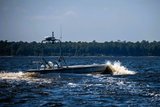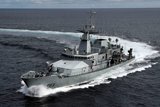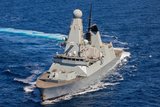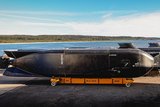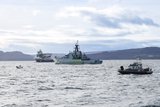US Navy solicits Raytheon and Lockheed for carrier-suitable hypersonic weapon
HALO will be the follow-on to the LRASM (pictured). (Photo: Lockheed Martin)
HALO will be an aircraft carrier-based missile giving greater anti-surface capability than any weapon in service today.
The initial contracts are worth $116 million and cover technical maturation and development through a preliminary design review of the propulsion system needed for a carrier-suitable hypersonic weapon.
The contract period for both awards will end in December 2024, with both companies' preliminary design reviews working towards flight testing of a prototype.
Related Articles
US Army taps Lockheed Martin to develop future long-range manoeuvrable missile
USN Precision Strike Weapons (PMA-201) programme manager Capt Richard Gensley said: 'As threat capability continues to advance, additional range, warfare capability and capacity is required to address the more demanding threat environment.'
The work is part of the USN's long-range fires investment approach, with hypersonic weapons as a top priority of the US's National Defense Strategy.
'Our team is leveraging science and technology and rapid prototyping arenas to support aggressive schedule execution,' Gensley added.
HALO will succeed the currently fielded Long Range Anti-Ship Missile (LRASM), launched from the F/A-18 and USAF B-1Bs.
The navy will bridge the gap to HALO by upgrading existing weapons with hardware and software improvements.
The USN is planning for the initial operating capability of HALO in the late 2020s.
More from Naval Warfare
-
![MBDA-led DragonFire’s latest trials move the LDEW system closer to UK Navy integration]()
MBDA-led DragonFire’s latest trials move the LDEW system closer to UK Navy integration
The DragonFire lines up with other European laser-directed energy weapons being developed in collaboration with MBDA.
-
![US Coast Guard pursues solutions to increase maritime domain dominance]()
US Coast Guard pursues solutions to increase maritime domain dominance
The USCG is seeking technologies, services and applications to better connect its assets and speed up the decision-making process.
-
![Canadian Coast Guard’s OOSV delivery is “major milestone” in fleet modernisation]()
Canadian Coast Guard’s OOSV delivery is “major milestone” in fleet modernisation
The Polar Class 6 platform is the largest CCG science-dedicated vessel and will operate on the country’s east coast.
-
![How the Anduril-HHI autonomous ship plan fits in with the US Navy’s MASC programme]()
How the Anduril-HHI autonomous ship plan fits in with the US Navy’s MASC programme
The new modular vessel is expected to be developed for both commercial and defence use, with a heavy focus on production speed and mission flexibility.
-
![Indo Pacific 2025: Autonomous systems reigned but can the Australian Defence Force afford it?]()
Indo Pacific 2025: Autonomous systems reigned but can the Australian Defence Force afford it?
Multiple autonomous systems and technologies were on display at this year’s Indo Pacific, but questions remain over how the Australian Department of Defence will balance the books.
-
![How the UK Royal Navy is powering up its hybrid fleet to combat new threats]()
How the UK Royal Navy is powering up its hybrid fleet to combat new threats
Since it announced its move towards a new “hybrid navy” earlier this year, the force has announced a number of new uncrewed technologies in the works.









